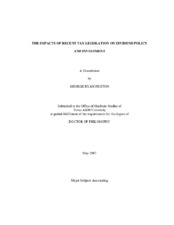| dc.description.abstract | This dissertation examines firms’ reactions to two changes in tax law intended to
increase dividend payout and capital investment, the Job Creation and Worker
Assistance Act (JCWAA) of 2002 and the Jobs Growth Tax Relief Reconciliation Act
(JGTRRA) of 2003. Chapter IV assesses whether firms assuage agency conflicts
between management and shareholders created by changes in individual-level taxes on
dividends, focusing on the impact of board independence on changes in management
compensation and dividend policies. Data analyses suggest that greater board
independence mitigates the effects of both CEO stock and option holdings on dividend
increases. Additionally, firms appear to implicitly dividend-protect options through
increased cash compensation, effectively reimbursing CEOs for decreases in option
value. Firms that did not increase dividends in the first year following the passage of
JGTRRA decreased option grants to induce greater future dividend payouts.
Chapter V examines the relation between contemporary dividend increases and
future earnings around JGTRRA. Specifically, I investigate whether firms increase
dividends in response to shareholder demands, and I examine the market reaction to preand
post-JGTRRA dividend changes. In addition, I focus on the dividend policies of growth firms, testing between firm maturation (Grullon et al. 2002) and tax-based
explanations. Results suggest that dividends are less explanatory as to future earnings in
the post-JGTRRA period. Post-JGTRRA dividend increases by growth firms are
consistent with tax motives rather than firm maturation because growth firms paying
dividends have greater investment in the post-JGTRRA period.
Chapter VI examines the effects of JCWAA and JGTRRA provisions enacted to
increase business capital expenditures through increased depreciation allowances. I
develop a model to predict what firms’ capital expenditures would have been in the
absence of these acts, comparing the actual and predicted values. I find firms
significantly increased purchases of qualified assets but decreased nonqualified asset
purchases, netting only a marginal overall increase in capital expenditures. Finally, I
examine the impact of these acts on leasing transactions, finding that low marginal tax
rate firms significantly increased use of operating leases following the passage of
JCWAA, whereas firms with higher MTRs decreased lease transactions. | en |


